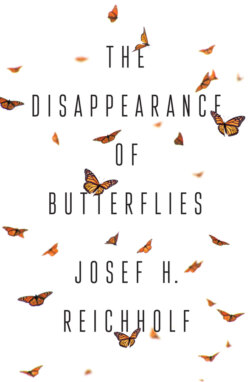Читать книгу The Disappearance of Butterflies - Josef H. Reichholf - Страница 20
The destruction of the biotopes of the little nymphs
ОглавлениеThe detailed portrayal of their lifestyle set out above could give the impression that aquatic moths only have such a major role in my book because my research into butterflies and moths started with them. However, they serve as an illustration for the precarious situation in which so many butterflies and moths have ended up. As I shall explain in more detail below, the water-filled gravel pits in which they lived when I carried out my doctoral research no longer exist. They have been buried, filled in. Those that were in the open fields have been reincorporated into agricultural land. They belong to the large group of small structures of which farming land has been ‘cleansed’. In this manner, the aquatic moths and many other butterflies and moths lost the biotopes in which they had flourished for many decades. Dozens of moths and butterflies – and, if one includes the smaller species, surely more than a hundred, as well as hundreds of other insects – made these gravel pits into islands of species diversity at the time when the homogenization of the fields was just beginning. In the opinion of certain influential nature conservationists at the time and of those authorities with jurisdiction over the excavation sites, gravel extraction had to be regulated and concentrated in special cultivation areas that should, of course, be as large as possible. When gravel extraction was complete, they could be repurposed as swimming ponds or, if of largely dry construction, could be recultivated as arable land or woods. It was this same trend that moved away from small- and medium-scale enterprises towards large businesses, and which could simultaneously be seen in agriculture.
With my studies of aquatic moths, I was only able to record a narrow spectrum of the insects that lived in gravel pits and small waterbodies. I observed their colony loss through the disappearance of the ponds in which dragonflies and frogs, and in dryer areas also lizards and beetles, had been comfortable. One by one, hedgerows and field copses also disappeared. The riparian woods by the River Inn were almost totally uprooted because of booming maize cultivation: the land was now worthless for growing trees, since firewood was no longer in demand, but had become highly profitable for farmers if they planted maize. The ban on woodland clearance came too late. Large parts of the riverine woods had already been destroyed and were further cleared over the years because the authorities did nothing to prevent it from happening. Perhaps it was only thanks to a series of wet summers that the wetter riparian woods along the River Inn remained untouched. Financial incentives for clearing woodland were eventually stopped.
It is with very mixed feelings that I think back to the 1970s when the fight for these alluvial forests played itself out and nature conservationists like me could only watch helplessly as piece after piece was cleared and converted into maize fields. The media and the general public were not very interested at the time. Such species-rich areas were referred to in the official parlance as ‘wasteland’ or ‘barren land’, descriptions that say everything about the value placed by large-scale agriculture upon animals and plants that have no direct commercial use. Sometimes I doubt whether our attitude to what is truly noteworthy has changed at all, even though one seldom hears talk of wasteland anymore. Words are interchangeable; it is far harder to change their underlying meaning, and there are setbacks time and again. Decades of serious attempts to replace the terms ‘raptor’ and ‘predator’ in Germany with ‘bird of prey’ and ‘carnivore’ (on the basis that ‘prey’ only exists in the eyes of the hunter) were fruitless. For some reason, young journalists in Germany have started using the term ‘raptor’ again quite openly, even though it disappeared from ornithological books long ago. ‘Pest’ is once again used for insects, regardless of whether or not they cause damage intentionally or even whether they cause any damage at all.
My aquatic moths caused no damage in the wild, in the small bodies of water or on lake shores. Unfortunately, the same could not be said of waterlily ponds. Water-lily species with thin leaves, in particular, were devoured by caterpillars, resulting in nothing more than an eyesore. In a garden pond with small, pink-flowering water-lilies most people want flawless floating leaves and, if possible, flowers that have not been spoilt by aphids. But anything that interferes with their look counts as damage, and for many an owner of such garden ponds it would be better if the little moths did not exist at all. Tropical aquatic moths also cause severe harvest losses in rice fields. The opportunity offered to me by the FAO (Food and Agriculture Organization) to carry out my investigations there did not attract me. The moths and butterflies that lived around us were interesting enough. Little was known in the 1970s about moths, apart from the forest pests. Nevertheless, it is the nocturnal moths, not their diurnal relatives the butterflies, that make up by far the largest proportion of the Lepidoptera species. Light itself would shed light on the darkness.
1 * The changes to the genus names and their current form are explained on page 112. They are hopefully now permanent.
